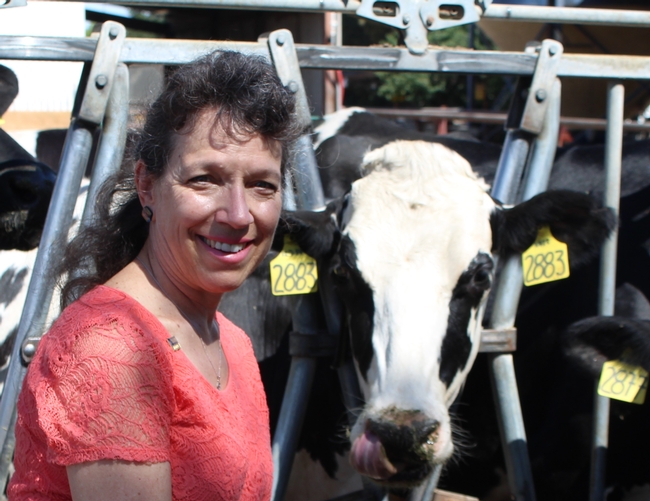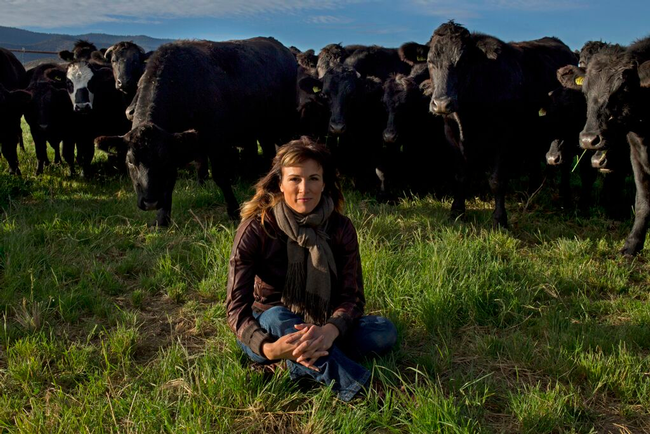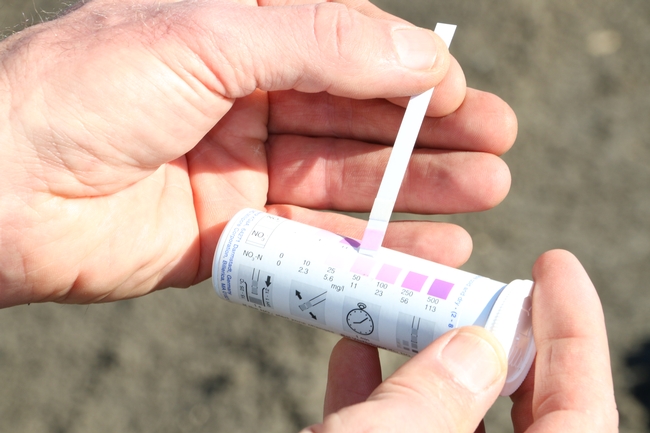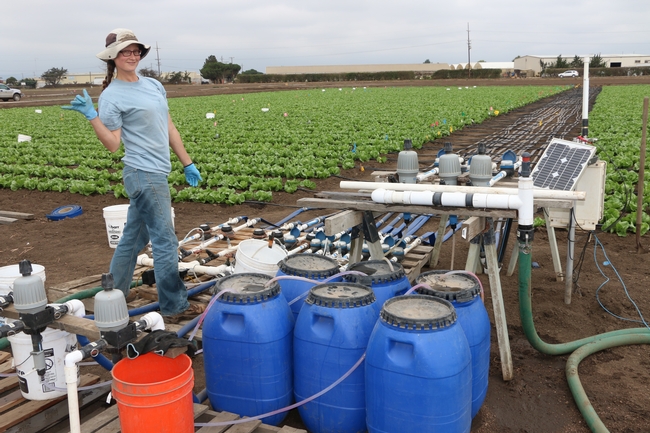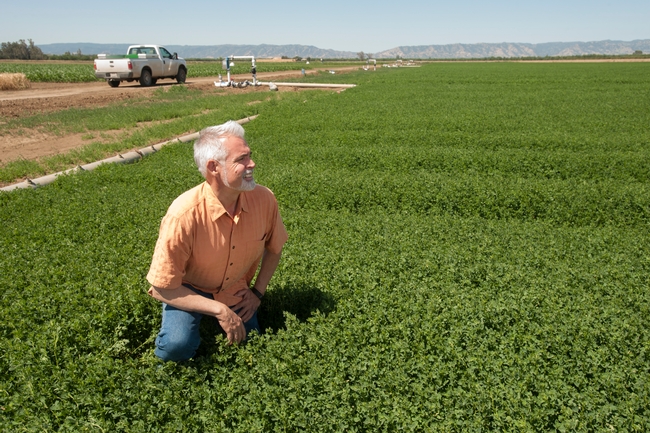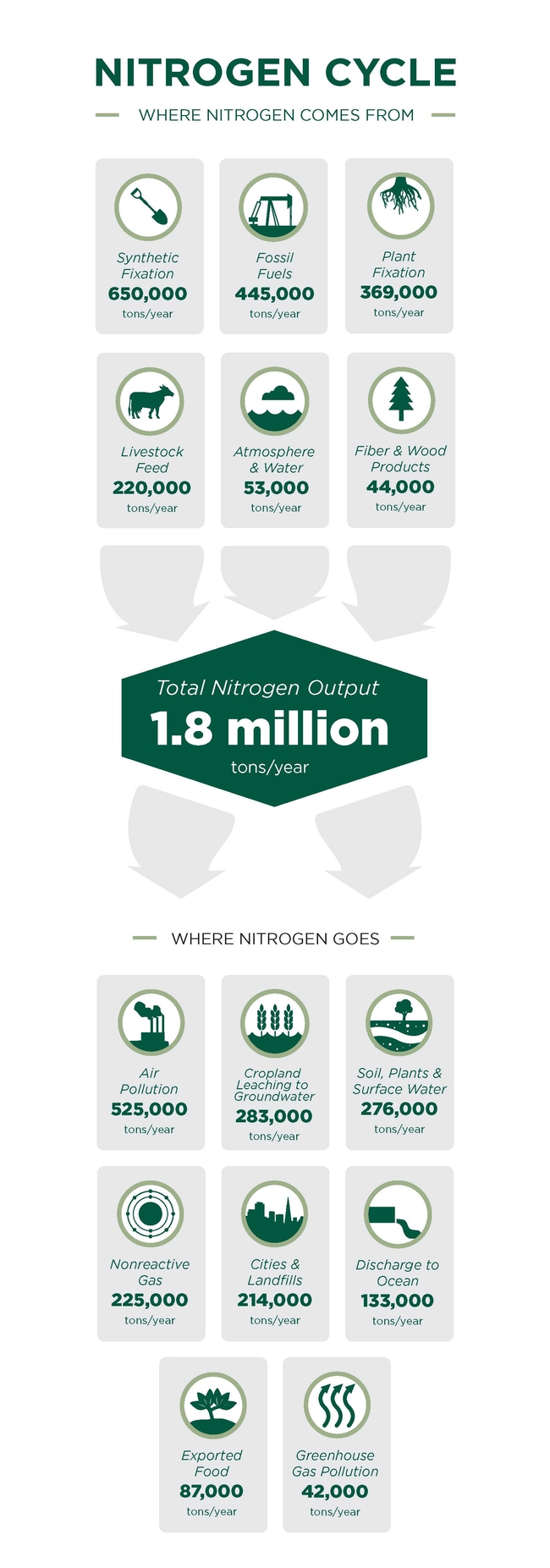
Posts Tagged: agricultural sustainability
Meyer receives Bradford-Rominger Agricultural Sustainability Leadership Award
Deanne Meyer, UC Cooperative Extension livestock waste management specialist, is this year's recipient of the Eric Bradford & Charlie Rominger Agricultural Sustainability Leadership Award, given by the Agricultural Sustainability Institute (ASI) at UC Davis.
Meyer is being honored for her leadership in substantially improving the sustainability of California's dairy industry through her research and outreach.
The Bradford-Rominger award recognizes and honors individuals who exhibit the leadership, work ethic and integrity epitomized by the late Eric Bradford, a livestock geneticist who gave 50 years of service to UC Davis, and the late Charlie Rominger, a fifth-generation Yolo County farmer and land preservationist.
Meyer has directed the environmental stewardship efforts of the California Dairy Quality Assurance Program (CDQAP)—a voluntary partnership between the dairy industry, government and academia—since the program's inception in 1996.
Meyer's dedication to build a bridge between industry and regulatory agencies has paid dividends for California's air and water quality. With Meyer's leadership, more than 700 dairy farms have completed an on-site, third-party evaluation of their facility's manure management. The program has been so successful that it received California's highest environmental honor, the Governor's Environmental and Economic Leadership Award, in 2007.
Reflecting on Meyer's work, Glenda Humiston, UC vice president for agriculture and natural resources, said, “Serving as chair of California's Water Quality Task Force in the mid-1990s, I had a front row seat to the challenges Deanne faced as she organized CDQAP and brought many unlikely allies to the table. The many successes of that program is a testament to her skills as both a scientist and a diplomat.”
Beyond Meyer's work with CDQAP, her research in groundwater salinity has provided farmers, agency staff and other concerned stakeholders with unbiased information presented with an understanding of agricultural realities.
“Her efforts, leadership, and dedication are so valued by all the diverse sectors she works across,” said Anita Oberbauer, professor and dean for Agricultural Sciences at UC Davis. “By working closely with regulatory agencies and farmers, she ensures our state's livestock and dairy producers have the tools that they need to meet the environmental challenges.”
Learn more about the Bradford-Rominger award on the Agricultural Sustainability Institute's website.
Past winners of the Bradford-Rominger award include UC Cooperative Extension advisors Rachael Long, Rachel Surls and David Lewis, Sustainable Conservation's Director of Resources Daniel Mountjoy; UCCE advisor Rose Hayden-Smith, UCCE specialist Ken Tate, UCCE advisor Mary Bianchi, natural resource conservation consultant Kelly Garbach and UC Davis lecturer emeritus Isao Fujimoto.
A nutty idea: A little stress could be good for walnuts
When it comes to watering walnuts, most California growers believe you need to start early to keep trees healthy and productive throughout the long, hot summer. But according to striking results from a long-term experiment in a walnut orchard in Red Bluff, growers can improve crop production if they hold off irrigation until later in the season and directly measure their trees' water needs.
The findings from researchers at the University of California may help farmers optimize water use.
“It's a game-changer,” said walnut grower Hal Crain, who welcomed researchers on to his orchard to test irrigation optimization. “It's clear to me you can improve nut quality and yield by applying water based on what the tree wants and needs, rather than just watering when it's hot outside and the soil is dry. That's a big deal for walnut growers and for the entire agricultural industry.”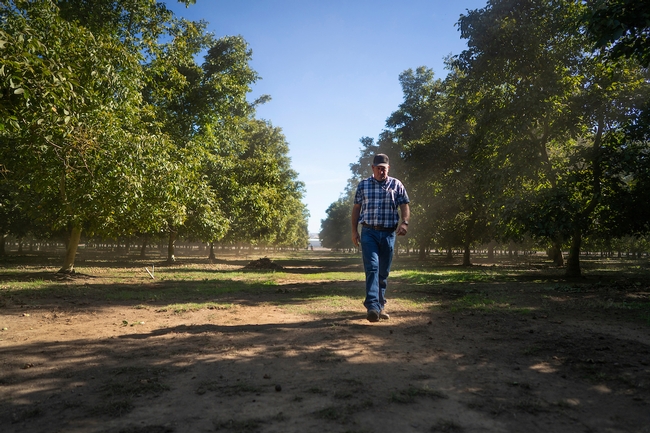
Changing the paradigm
Crain is a second-generation farmer whose family has been growing walnuts in Butte and Tehama counties for 55 years. Like most walnut farmers, Crain had always started irrigating in early to mid-May when the days grew warmer and the trees sprouted leaves.
“That's standard practice for probably 90 percent of California's walnut growers,” said Crain, walking amid his trees on a sunny afternoon. “The theory is that when you irrigate early, you preserve the deep moisture in the soil that trees need to survive the heat of summer.”
But that's not how it works, the research shows. Instead, trees that grow in saturated soil early in the season don't develop the deep roots they need to thrive.
“With all the water right there at the surface, the lower roots suffer,” explained Bruce Lampinen, UC Cooperative Extension orchard management specialist with the UC Davis Department of Plant Sciences. “Trees end up with a very shallow root system, which doesn't serve them well as they try to extract moisture from the soil later on.”
Lampinen has long suspected that walnuts were getting too much water in the spring.
“A lot of the symptoms we see like yellowing leaves and various diseases can all be explained by overwatering,” said Lampinen.
So Lampinen did what scientists do: He set up an experiment. Five years ago, with funding from the California Walnut Board and the U.S. Department of Agriculture, he joined forces with Ken Shackel, a plant sciences professor with UC Davis, and Allan Fulton, an irrigation adviser with UC Cooperative Extension. Together, they led a team of scientists testing irrigation on Crain's ranch.
“Hal is an exceptional partner,” Fulton said. “Farmers have a lot to accommodate when they host an experiment like this, with researchers going in and out of the orchard at all hours. He had to work around our people and the timing of our water treatments. He's always eager to experiment with technology and learn new things, and he shares what he learns with other growers. Hal completes the circle.”
Tough nut to crack
When is the best time to irrigate? Researchers say the trees hold the answer. Scientists use pressure chambers, which are air-pressure devices that measure a leaf or small shoot to gauge how hard the plant is working to pull moisture from the soil.
“Just because the soil looks dry doesn't mean the plant is suffering,” said Shackel, who specializes in plant physiology. “Pressure chambers let you ask the tree how it's feeling — sort of like taking a human's blood pressure — which is a much more accurate way to measure a plant's water needs.”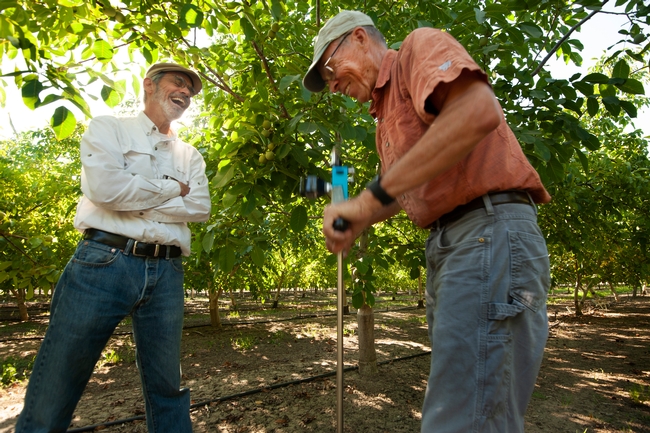
For the last five years, the team has been applying different water treatments to five blocks of trees. One block is getting standard, early irrigation. Crain's orchard managers begin irrigating the other blocks when the trees reach different levels of water stress based on pressure-chamber readings.
The trees that experience moderate stress are doing the best. Their irrigation usually starts in mid-to-late June, several weeks later than when standard watering begins.
“You can tell just by looking at that block that the trees are healthier,” said Crain, standing beneath a canopy of lush, green trees. “And, we're starting to see greater yields and better nut quality.”
Translating the research
The research is helping scientists advise farmers on irrigation.
“My biggest take-away is knowing when to start watering is a really important factor to the health of your trees,” Lampinen says.
Pressure chambers — sometimes called pressure bombs — can cost more than $3,000, and high-tech versions are under development.
“I tell growers a pressure bomb would pay for itself even if you just used it once a year to determine when to start watering,” Lampinen said.
Crain is certainly convinced.
“When you irrigate based on your trees' needs, you optimize water,” Crain says. “I'm not using less water overall, but the water I do use is producing more food. That's good news for everyone.”
This story was originally published in the Fall 2018 issue of Outlook Magazine, the alumni magazine for the UC Davis College of Agricultural and Environmental Sciences.
David Lewis to receive Bradford Rominger Agricultural Sustainability Leadership Award
The Agricultural Sustainability Institute (ASI) at UC Davis has announced that David Lewis, UC Cooperative Extension watershed advisor for California's north bay and UC Davis alumnus, is this year's recipient of the Eric Bradford and Charlie Rominger Agricultural Sustainability Leadership Award.
For 17 years, Lewis has served as a UC Cooperative Extension advisor, helping farmers, ranchers, conservationists, and other stakeholders solve challenging and contentious issues surrounding the health of their watersheds.
The Bradford Rominger award honors individuals who exhibit the leadership, work ethic and integrity epitomized by the late Eric Bradford, a livestock geneticist who gave 50 years of service to UC Davis, and the late Charlie Rominger, a fifth-generation Yolo County farmer and land preservationist.
“David epitomizes the very fiber of character that this award celebrates,” says Kenneth Tate, Russell L. Rustici Endowed Chair in Rangeland Watershed Science at UC Davis and 2012 Bradford Rominger award recipient.
After starting his work in sustainability with the Peace Corps in Africa and completing a master's degree in international agricultural development at UC Davis, Lewis joined UC Cooperative Extension as its first watershed advisor.
Tate praises Lewis' ability to “put his quiet, honest, credible manner to good work” to help build trust and understanding so communities can have frank discussions about the challenges facing their watersheds.
Lewis' accomplishments include helping to reduce the dairy pollution hurting the oyster beds of Tomales Bay and helping ranchers reduce erosion on their property, letting them play a key role in conserving critical coho salmon habitat and protecting the water quality of north coast rivers.
“I help my communities work towards a shared goal,” says Lewis, reflecting on his role as a leader.
“Marin County and places like it have placed a value on open working landscapes, and made land use policies 40 years ago to protect them. As we face new challenges, whether it's a new invasive weed or where solar panels can go, we can always go back to that shared value.”
For Lewis, many of those successes stem from an eagerness to hear and understand the needs of community members, something he considers a privilege of his job.
“When talking with people at their kitchen tables or at the gates at their ranches, I get to feel the deep knowledge and connection people have with the landscape, hear their family histories and desires to innovate and do something different. And I appreciate that I've got a small role in it somewhere.”
Lewis will be presented the award at the Shepherds of Sustainability: Celebrating Leadership in Watersheds, Rangeland, and Livestock Sustainability event April 19 in Davis. The event is free and open to the public. Students are strongly encouraged to attend.
The Shepherds of Sustainability event will include an award ceremony and talks by David Lewis and keynote speaker Anya Fernald, CEO of Belcampo — a collection of organic ranches, butcher shops, and restaurants in California and an agritourism venture in Belize — on the topic of expanding awareness and access to sustainable foods. Fernald was recently recognized in Food & Wine's “40 under 40” list and featured in profiles in The New York Times and The New Yorker, and has served as a regular judge on Iron Chef America.
More Information on the event and award can be found on the Agricultural Sustainability Institute's website.
Shepherds of Sustainability: Celebrating Leadership in Watersheds, Rangeland, and Livestock Sustainability event & Bradford Rominger award ceremony
Wednesday, April 19
International House Davis, 10 College Park, Davis
| 4:00 p.m.: | Student only discussion with David Lewis and Anya Fernald on leadership in agricultural sustainability |
| 5:30 p.m.: | Award ceremony and talk by Anya Fernald on the topic of expanding awareness and access to sustainable foods |
| 7:00 p.m.: | Reception |
California nitrogen assessment presents opportunities for improvement
Plants need nitrogen to grow, but excess nitrogen – from livestock facilities, septic systems, car exhaust and other sources – that escapes into groundwater and the air can impact the environment, human health and the climate.
A new report from the Agricultural Sustainability Institute at UC Davis offers a big picture look at the scale and impacts of nitrogen in California. According to the California Nitrogen Assessment, excess nitrogen in the state comes primarily from agriculture and fossil fuel combustion.
The report, published by UC Press, offers a scientific foundation to develop practices and policies that allow nitrogen's benefits while reducing the risk.
For years, UC Agriculture and Natural Resources scientists have been working with farmers throughout the state to refine fertilizer management, irrigation efficiency and other farming practices to manage nitrogen, and the work continues.
The following are some examples of UC ANR research and extension projects underway.
App helps farmers better manage nitrogen fertilizer and water
Growers can use CropManage, developed by Michael Cahn, UC Cooperative Extension advisor in Monterey County, and UC ANR Communication Services and IT staff, to track and manage water and nitrogen fertilizer applications for their crop fields. The online application can be used on mobile devices or computers to help farmers use two tools to conserve water and make better use of nitrogen fertilizer while maintaining crop productivity and quality. Growers use the soil nitrate quick test in the field to measure the nitrogen level of their soil and the app to determine the optimal level of nitrogen fertilizer to apply based on UC ANR research on crop nitrogen use. CropManage also recommends water needs of a crop from weather station data and crop development models.
Matching nitrogen applied to crop need improves efficiency
Richard Smith, UC Cooperative Extension advisor in Monterey County, is leading several research projects evaluating the nitrogen requirements of vegetables including including cole crops, spinach, baby lettuce, a salad mix and cilantro. Smith is evaluating crop rotations with broccoli to scavenge nitrogen from the soil profile. He is also evaluating slow-release fertilizers to minimize nitrate leaching losses in shallow-rooted crops such as baby lettuce and spinach in the Salinas Valley.
Wood chips remove nitrogen in tile drain water
Using wood chips and supplemental carbon sources, Tim Hartz, UC Cooperative Extension specialist in the UC Davis Department of Plant Sciences, worked with Cahn and Smith to refine a process to remove nitrate from tile drain water, which typically is very high in nitrate. The carbon in the wood chips supports the activity of anaerobic bacteria that chemically reduce the nitrate to N2, a benign gas.
Irrigation water fertilizes vegetables
Water quality regulations in many regions of California now require farmers to report the amount of nitrogen fertilizer that they apply to their fields and the nitrate concentration of their irrigation water. Smith, Hartz and Cahn have just finished three seasons of field trials that demonstrated that the nitrate in groundwater supplied a substantial portion of the fertilizer requirements for lettuce and broccoli. By accounting for the nitrate in irrigation water and using the soil nitrate quick test to monitor soil nitrogen levels, growers may be able to significantly reduce the amount of fertilizer nitrogen they apply to vegetable crops.
Micro-irrigation offers almond growers a tool to control leaching
The majority of almond growers apply fertilizer through micro-irrigation systems and an increasing number of growers are irrigating with water that is saline. Patrick Brown, professor in the UC Davis Department of Plant Sciences, is studying how to use micro-irrigation to reduce nitrate leaching and manage soil salinity by varying the frequency of irrigation and the length of time water is applied during irrigation.
Managing irrigation to reduce nitrate leaching
To identify the best irrigation management practices to control soil salinity and to minimize nitrate leaching to groundwater, Laosheng Wu, professor and UC Cooperative Extension specialist in the UC Riverside Department of Environmental Sciences, is using computer simulation to consider soil, water, crop nitrogen demand and fertilization with irrigation methods. In collaboration with UC Cooperative Extension advisors, Wu is conducting field experiments on alfalfa in Imperial County, almonds in the Central Valley and avocados at South Coast Research & Extension Center in Orange County to validate the simulations.
Online tool being developed to estimate soil nitrogen mineralization rates
To develop a tool for growers and crop advisers to estimate soil nitrogen, Daniel Geisseler, UC Cooperative Extension specialist in the Department of Land, Air, and Water Resources at UC Davis, is gathering data throughout California to estimate field-specific nitrogen mineralization rates. This project, funded by UC ANR's California Institute for Water Resources, will use nitrogen mineralization data to develop an online tool to help growers adjust their applications of fertilizer. The tool has the potential to increase nitrogen use efficiency in crop production, resulting in lower risks of nitrate leaching to groundwater.
Nitrogen management training for Certified Crop Advisers
Between 2014 and 2016, approximately 900 Certified Crop Advisers participated in a nitrogen management training program coordinated by UC ANR's California Institute for Water Resources with support from CDFA's Fertilizer Research and Education Program. The technical and applied training improves CCAs' understanding of sound nitrogen management practices to make informed recommendations to growers.
The California Nitrogen Assessment book
The book, “The California Nitrogen Assessment: Challenges and Solutions for People, Agriculture, and the Environment,” is available for purchase at ucpress.edu. The 20-page executive summary can be downloaded for free at asi.ucdavis.edu.
This story is also available in Spanish: "La evaluación del nitrógeno en California ofrece oportunidades para mejorar http://ucanr.edu/sites/Spanish/Noticias/boletines/?uid=6884&ds=199
First state-level nitrogen assessment shows the state of the science on nitrogen use and pollution
California paves the way for reconciling agriculture and the environment
Nitrogen is essential for agriculture but also has health and environmental impacts. The California Nitrogen Assessment, a new report from the Agricultural Sustainability Institute at the University of California, Davis presents a big picture of the scale and impacts of nitrogen in the state. The report, published by UC Press, offers a scientific foundation to develop practices and policies that balance nitrogen's benefits and harm.
It's easy for nitrogen to become too much of a good thing, according to the report, which is the first state-level nitrogen assessment. Excess nitrogen can pollute groundwater and air, and impacts the environment, human health, and climate change.
The report shows that excess nitrogen in the state comes primarily from agriculture and fuel combustion.
“This problem was created by all of us,” said lead author Tom Tomich, director of the Agricultural Sustainability Institute at UC Davis. “Nitrogen is an issue that affects and is affected by every Californian.”
The seven-year, multi-institutional assessment identifies how much nitrogen enters the state, where it is used, and its eventual fate. It consolidates existing scientific knowledge and weighs options for addressing nitrogen management.
“Many programs in California have been recently put in place to help balance the benefit and harm of nitrogen use,” Tomich said. “The California Assessment hopes to contribute to long term solutions and we see farmers as the leaders in positive change.”
Agriculture the major source of California's nitrogen
Each year, about 1.8 million tons of nitrogen enter California. Agriculture represents the largest source of California's nitrogen imports from synthetic fertilizer, livestock feed, and nitrogen-fixing crops, which pull nitrogen from the air and convert it into a usable plant nutrient.
Nitrogen fertilizer helps California produce 21 percent of the nation's dairy commodities and more than half of the nation's fruits and vegetables.
However, vegetable and fruit crops throughout the state use only half of the nitrogen applied to them on average. For livestock, only about a quarter of the nitrogen in animal feed becomes meat or dairy products. The remaining 75 percent becomes manure, which can emit nitrogen into the air as ammonia, a known air pollutant.
Much excess nitrogen from crops leaks into soil and eventually the state's groundwater. Sixteen percent of the state's net nitrogen imports each year, accumulate in groundwater, and 11 percent of nitrogen from crop land and livestock is lost as air pollution.
Nitrogen in groundwater linked to health issues
Nitrogen leaches into groundwater as nitrate, which has been linked with blue-baby syndrome in infants, adverse birth outcomes, and various cancers. While most adults consume more nitrate through food than through drinking water, people who rely on contaminated wells may take in the majority of their nitrate through drinking water.
Parts of the state regularly fail to meet federal drinking water standards for nitrates, and previous reports have shown low-income Latino communities in agricultural regions are the most exposed to groundwater nitrate contamination.
Excess nitrogen in the environment can have detrimental impacts on crop yields, native species and biodiversity, as well.
Nitrogen, fossil fuels, and air pollution
Fossil fuel combustion is responsible for nearly a quarter of the nitrogen coming into the state in the form of nitrogen oxides, which contribute to ozone formation, and ammonia, a component of particulate matter.
Well-established scientific evidence links ozone and particulate matter to poor respiratory and heart health.
Much of the nitrogen oxides and ammonia produced in California are transported downwind from California, making the state a major exporter of nitrogen air pollution.
A very small amount of the state's nitrogen, 2 percent, is released as nitrous oxide, a potent greenhouse gas. Nitrous oxide emissions account for 4 percent of California's total greenhouse gas emissions.
Emissions have declined since 1980 as regulations have pushed fuel efficiency advancements, but nitrogen-related air pollutant levels still exceed state recommendations in many areas.
The path forward
The dispersed, “non-point” nature of nitrogen pollution makes achieving solutions especially challenging. A one-size-fits-all approach will not work for managing nitrogen.
The report highlights practices farmers and ranchers can use to decrease nitrogen losses and save money, such as reducing nitrogen application rates and timing nitrogen application closely with irrigation, practices many farmers in California already are using.
“California has amazing resources to address this issue,” said Rich Rominger, a California farmer and former Director of the California Department of Food and Agriculture. “The state has skilled and motivated farmers and a university system that can continue to dive deep into our unanswered questions about nitrogen. California is often looked to as both an agricultural innovator and an example of strong environmental policy. How we deal with nitrogen can enhance our leadership in these areas.”
The California Nitrogen Assessment was funded primarily by the David and Lucille Packard Foundation, as well as by the UC Division of Agriculture and Natural Resources (UC ANR), and the UC ANR Kearney Foundation of Soil Science.
The book is available at ucpress.edu, and summary materials are available at asi.ucdavis.edu.
More information:
Read the executive summary.
The book, The California Nitrogen Assessment: Challenges and Solutions for People, Agriculture, and the Environment,is available at ucpress.edu.

